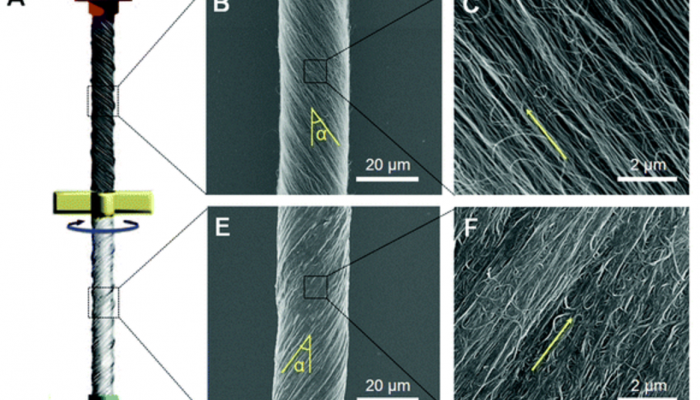 Cheong Hoon Kwon, Kyoung-Yong Chun, Shi Hyeong Kim, Jae-Hyeok Lee, Jae-Ho Kim, Mrcio D. Lima, Ray H. Baughman, Seon Jeong Kim
Cheong Hoon Kwon, Kyoung-Yong Chun, Shi Hyeong Kim, Jae-Hyeok Lee, Jae-Ho Kim, Mrcio D. Lima, Ray H. Baughman, Seon Jeong Kim
Center for Bio-Artificial Muscle and Department of Biomedical Engineering, Hanyang University, Seoul, Korea
*Corresponding author.E-mail: sjk@hanyang.ac.kr.
원문 링크 : http://seonjeongkim.cafe24.com/link
Abstract
Torsional behaviors of polymer-infiltrated carbon nanotube (CNT) yarn muscles have been investigated in relation to molecular architecture by using atomic force microscopy (AFM). Two polymers with different stiffnesses, polystyrene (PS) and poly(styrene-b-isoprene-b-styrene) (SIS), were uniformly infiltrated into CNT yarns for electrothermal torsional actuation. The torsional behaviors of hybrid yarn muscles are completely explained by the volume change of each polymer, based on the height and full width at half maximum profiles from the AFM morphological images. The volume expansion of the PS yarn muscle (1.7 nm of vertical change and 22 nm of horizontal change) is much larger than that of the SIS yarn muscle (0.3 nm and 11 nm change in vertical and horizontal directions) at 80 °C, normalized by their values at 25 °C. We demonstrate that their maximum rotations are consequently 29.7 deg mm−1 for the PS-infiltrated CNT yarn muscle (relatively larger rotation) and 14.4 deg mm−1 for the SIS-infiltrated CNT yarn muscle (smaller rotation) at 0.75 V m−1. These hybrid yarn muscles could be applied in resonant controllers or damping magnetoelectric sensors.